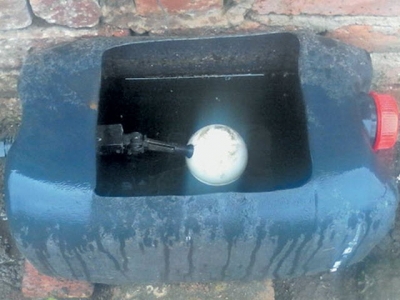Water availability: crucial to profitable livestock production

Fresh water is becoming an ever-scarcer resource. This places all forms of agriculture, including livestock farming, under increasing pressure, warns Shane Brody.
This trough is easy to make and durable. All material is available from your local co-op. Photo: Shane Brody
A successful sheep farmer recently told me that the availability of good water accounted for 80% of the value of his operation.
An animal’s biological processes depend on having enough water in its body. For example, water plays a crucial role in the digestion of feed in the rumen.
A cow suffering from dehydration becomes constipated; this, in turn, affects her appetite, preventing her from feeding properly.
Similarly, a dehydrated sheep cannot digest grass in its rumen successfully. This means that nutrients merely pass through the body.
Livestock deprived of water, particularly in winter when grass is dry, will always be in poor condition.
Milk production will be reduced, and offspring will either become stunted or take far longer to grow. Their immune systems may be comprised, leading to opportunistic infections or a parasite infestation, which could prove fatal.
The end-result for the farmer is low productivity and a dramatic drop in income.
Rain tanks
A storage tank is an efficient means of storing rainwater, but it requires a catchment area such as a roof from where the rainwater runs into the tank. Any old building, pump house, shed or structure with a roof can be used for this purpose, and troughs can be attached to the tank.
A simple, but sturdy, open-sided pole structure, using old corrugated iron sheets as a roof, can be erected at a selected site in each camp. This will fill a tank with rainwater during a heavy storm.
The larger the surface area of the roof, the more water it can collect. The structure can also provide shade for livestock.
Gutters feeding the tank should be firmly secured and cleaned regularly.
Dams
A small dam can be made, even by hand, to collect and hold water from a naturally occurring fountain or spring. Many farms, particularly in mountainous areas, have narrow seasonal ravines with bedrock or hard ground floors.
These are perfect places for constructing small weirs using concrete blocks. Such a structure should be fairly high (between 1m and 1,5m or so) and is best placed where the water does not flow too swiftly.
Strengthen the weir with vertically placed steel reinforcing rods of 14mm in diameter,
each metre across the ravine. Hammer the rods through the tops of the blocks as deeply as possible (0,8m to 1m) into the ravine floor and at the sides where the weir links to the ravine sides.
The weir itself should be two concrete block layers thick. Fill the hollow interior of the blocks with a stone-based concrete as they are laid; this will brace the reinforcing rods even further.
To strengthen the structure still further, lay brickforce mesh between each block course.
Silt may have to be removed from dams and weir areas from time to time, but this is not usually a problem in stony ravines. Some farmers, however, purposely leave silt in weirs to retard water flow and hence reduce soil erosion.
Mesh fencing can be spanned across these drinking areas. The surface can also be covered with old feed bags, shade cloth or even floating water lilies to reduce evaporation.
Supply sufficient water overnight
It is essential to supply water to animals kraaled overnight. Seven or eight hours of kraaling, particularly in summer or in kraals with salt licks or dry feed, can lead to physiological problems.
If camps or rangelands do not have enough water points, livestock will be forced to walk great distances to find water. This expends valuable energy and creates footpaths that later lead to soil erosion when it rains.
A homemade drinking trough
If you don’t have money to buy expensive drinking troughs, try the following:
- Take a 20ℓ plastic container that once held liquid molasses (nothing else!) and clean it well.
- Tighten the lid of the container and neatly cut a small hole in the opposite side; this is to insert a plastic or steel ball valve. I use a 20mm low-pressure plastic valve, which is cheap and easily replaced, so I cut a 20mm-diameter hole.
- Cut a rectanglar hole in the top of the container, as shown. Link the trough to your water source.
I’ve found that these homemade troughs are surprisingly durable and last a number of years. Just remember that the water source should be at least 1m higher than the troughs to enable water to flow into them.
Có thể bạn quan tâm
 200 tons of lychees exported to Thailand
200 tons of lychees exported to Thailand Around 200 tons of Luc Ngan lychees will be transported to Thailand through air freight to be sold on Thai retail networks, tripling the volume exported
 Breakthrough technology to 'position' Vietnamese agricultural products
Breakthrough technology to 'position' Vietnamese agricultural products In recent years, agricultural exports, forestry and fishery have brought in tens of billions of dollars a year, but the export goods are mainly raw products
 Vietnam still fumbles for way to bring fruit to global market
Vietnam still fumbles for way to bring fruit to global market High transportation, packaging and radiation fees all are pushing up prices of fruit, weakening the competitiveness of Vietnam’s fruit in the world market.